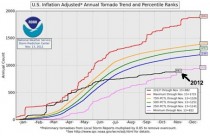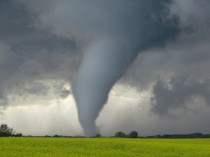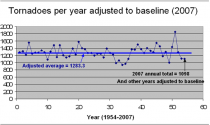By Jason Samenow
After one of the busiest years for tornadoes in 2011, tornado numbers in 2012 have come crashing down to historic lows.
In 2011, there were 1692 twisters - second most on record. This year, only 882 tornadoes have touched down. (Tornado records date back to 1950).

“[W]e are approaching a theoretical minimum in the annual tornado count for the modern era,” said Greg Carbin, warning coordination meteorologist at the National Weather Service Storm Prediction Center in Norman, Ok.
What’s especially remarkable about the year’s depressed numbers is that tornado activity got off to a red-hot start. Through mid-April, tornado counts were highest on record. But then, an extended tornado drought struck and the count ranking plummeted.
“[The] decrease in tornado activity coincided with the development of an extensive ridge of warm high pressure in the atmosphere across the western and central United States,” Carbin said.
He continued: “This high pressure area produced both record warm temperatures and extreme drought over much of the middle part of the continent into the summer and autumn. The high pressure also acted as a block in the middle and upper atmosphere with more transient but dynamic weather systems, that can lead to tornado development, being shunted northward into Canada.”
“Even when the high pressure weakened enough to allow for some of the more dynamic weather systems to move across the lower 48 states, shear in the atmosphere remained too limited to support more than isolated to occasional tornado events. These conditions didn’t result in a complete lack of severe weather as evidenced by the June 29 Derecho Event, it’s just that conditions supporting more widespread tornadoes were clearly suppressed by the large scale pattern.”
Although 6 weeks remain in 2012, it’s unlikely there will be enough tornado activity for the year to rise significantly in the historic rankings. November and December are the 3rd and 4th least active months of the year for tornadoes, with a combined average of 70 to 80 tornadoes.
Related: 2012 vs . 2011 tornadoes: A study in contrasts
* Because fewer tornadoes were detected in earlier decades compared to recent decades (because of lower population, less tornado awareness, and fewer observing networks), NOAA adjusts count estimates using a simple equation. More information.
But as the storm track shifted into Canada, our northern neighbor experienced a very active tornado season. The Weather Network reported Canada experienced more tornadoes in July than the entire U.S., with Saskatchewan the new tornado alley.

Saskatchewan has had upwards of thirty tornadoes this summer, with most happening in July. In a typical year, there’s an average of ten to twelve tornadoes in the province. What’s more, Saskatchewan alone had the same amount of tornadoes in July as the entire United States.
SPC has adjusted the tornado reports to account for increased population and improved detection. Removal of this upward trend is desirable because the increase in tornado reports over the last 54 years is almost entirely due to secular trends such as population increase, increased tornado awareness, and more robust and advanced reporting networks. By removing the upward trend and making the broad assumption that 2007 represents something closer to reality for annual tornado numbers, we can attempt to answer the question, “what constitutes a normal year with respect to modern-day tornado reports?”





